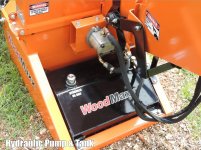handirifle
Veteran Member
I'm not building one, I bought it. It's one I have used several times, borrowed from a neighbor, and he's finally selling it. Got it for $500. I has a horizontal shaft 5.0 HP Honda and runs great. Piston is either 1.25 or 1.5", haven't measured yet. It's a homemade/modified unit. I think it was a factory unit at some point, but the PO didn't like how it was low to the ground, so he raised it to about waist level.
The ONLY mechanical thing is it has a slight leak at the hydraulic reservoir. This tank looks like a converted 1 gal gas tank, and the leak is at one of the welded on hose fittings.
I am considering building a new reservoir, but here's my question. The motor, pump, and reservoir currently sit side by side. I have some 4x4x1/8" tubing and was thinking of using it to make a new one. Does the reservoir HAVE to sit level or above the pump? The PO raised it by adding a 12" wide "C" channel at each end. The channels stand vertically and are about 18" tall. I would like to put the tank there with the fill cap about level with the bottom of the pump.
This would cause the supply line from the tank to be about 12-16" below the pump. Will this still work? I do not know if a hydraulic pump will self prime or not, so that is my concern.
I do not want to buy a tank and I think it might turn to a real hassle to try to repair the other one. It is VERY thin metal. I would repair it by brazing if I did it, but that is my last resort. I am also concerned that the 1 gal reservoir might not be enough. I can get specifics on the cylinder but it has an estimated 18" stroke, but that's a guess.
Any help is appreciated.
The ONLY mechanical thing is it has a slight leak at the hydraulic reservoir. This tank looks like a converted 1 gal gas tank, and the leak is at one of the welded on hose fittings.
I am considering building a new reservoir, but here's my question. The motor, pump, and reservoir currently sit side by side. I have some 4x4x1/8" tubing and was thinking of using it to make a new one. Does the reservoir HAVE to sit level or above the pump? The PO raised it by adding a 12" wide "C" channel at each end. The channels stand vertically and are about 18" tall. I would like to put the tank there with the fill cap about level with the bottom of the pump.
This would cause the supply line from the tank to be about 12-16" below the pump. Will this still work? I do not know if a hydraulic pump will self prime or not, so that is my concern.
I do not want to buy a tank and I think it might turn to a real hassle to try to repair the other one. It is VERY thin metal. I would repair it by brazing if I did it, but that is my last resort. I am also concerned that the 1 gal reservoir might not be enough. I can get specifics on the cylinder but it has an estimated 18" stroke, but that's a guess.
Any help is appreciated.


